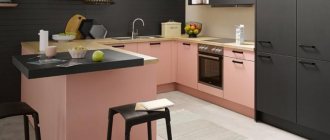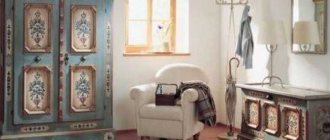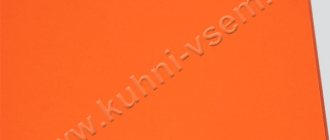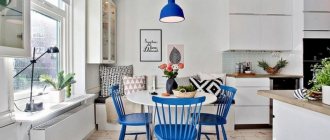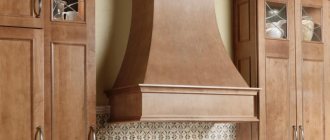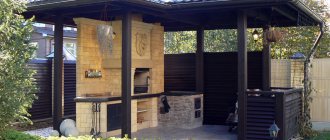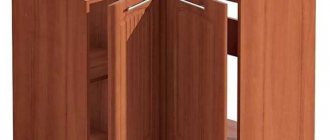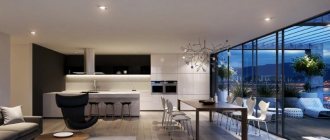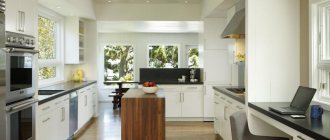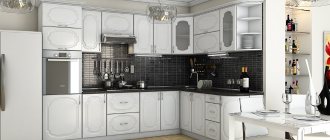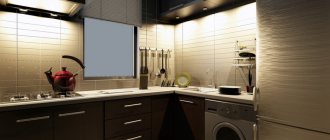Advantages
The main advantage of plastic kitchens is that the color range of the future set is not limited in any way - you can choose exactly the shade that perfectly suits your design. In addition, there are a number of operational advantages:
- resistance to damage. If you treat the set carefully and take good care of it, then the plastic kitchen will look like new in 10 years;
- resistance to household chemicals. This is one of the reasons why plastic kitchens last so long - they are not afraid of even the most aggressive household chemicals, so severe stains can be removed without consequences. The only thing is to beware of abrasive products;
- heat resistance. This property most likely applies to plastic countertops, which makes them very practical for cooking;
- moisture resistance. The atmosphere in the kitchen is characterized by high humidity and an abundance of splashes, but plastic does not absorb water, so it retains its appearance for a long time;
- UV resistance. Not all plastic kitchens can boast of this advantage, but most of them do. The color of the headset will not fade and change over time under the influence of sunlight;
- budget. Plastic kitchens combine good quality and reasonable cost, which natural materials cannot always boast of.
Types of plastic
Today there are many plastic products. Each type of material has its own characteristics, advantages and disadvantages. Let's look at the types of plastic we use in everyday life:
- PET or PET (PET, PETE) is polyethylene terephthalate; is a common type of plastic. It is used to produce disposable bottles, usually for carbonated and refreshing drinks. The main advantage of the material is water resistance. While glass is fragile and can break at any moment, plastic is many times lighter and more practical. In addition, the advantages include impact resistance, low cost and the ability to store large volume bottles.
- HDPE (HDPE) is a low-density high-density polyethylene. This type of plastic has the main advantage - it practically does not emit harmful components, and it is recommended to store liquids in it. The material is durable, resistant to oils and other elements, and has low transparency. Durable, durable plastic can be used to store a variety of foods, items and cleaning supplies.
- PVC (PVC) is polyvinyl chloride; is a dangerous type of plastic because it releases two chemicals that negatively affect the user’s hormonal balance. The material is soft and flexible. It is most often used for the production of blister packaging and storage of toys. PVC is used in the construction industry; pipes, garden hoses and plumbing parts are made from it. Plastic is not environmentally friendly and can only be recycled in some countries.
- LDPE is a low-density polyethylene of high pressure. Most often the material is used for the production of bottles and plastic bags. Bottles do not emit chemicals, while it is better to refrain from buying packages. The products contain compounds hazardous to the human heart.
- PP (PP) - white or translucent polypropylene. A distinctive feature of the material is heat resistance. PP is considered safe and does not melt when heated.
- PS (PS) - polystyrene, when exposed to heat, it involves the release of hazardous chemicals. Typically, it is used to produce coffee cups and food containers. Features of the material are affordable cost, light weight, durable plastic.
- O (OTHER) – other types of plastic.
It is recommended to study the types of plastic before purchasing products.
Flaws
But there are several disadvantages:
- difficult care. There are many myths around plastic kitchens - fingerprints of the whole family “become noticeable” on glossy or matte surfaces. Most often, this problem concerns dark headsets, so you should choose them very carefully, testing them with your fingers in the store;
- environmental friendliness. Plastic cannot boast of this feature. If the naturalness of materials is important, then it is better to take a closer look at wood;
- accumulation of dirt in the places where the edge and facade are fastened;
- yellowing of areas made of low-quality plastic.
Advantages and disadvantages of a plastic kitchen
Taking into account the structural features of plastic kitchens and the specific properties of materials that can be used in its production, we will outline the main advantages and disadvantages of such sets.
Let's start with the pros:
- Moisture resistance - plastic is not afraid of direct exposure to water.
- Wide variety of designs - thanks to the ease of painting and decorating, a plastic kitchen can have absolutely any color, texture and print. This determines the versatility of using PVC facades. Plastic finishing can imitate the texture of different materials: brick, wood, stone, paint.
Advice. If you want to get a unique set, resort to photo printing - thanks to modern technologies, any image can be applied to plastic.
- Durability - plastic is resistant to household mechanical influences, so the facade fabric is difficult to scratch or break.
- Easy to care for. Plastic does not absorb dirt, so it is very easy to clean - even greasy stains can be quickly removed using standard detergents.
Advice. Please note that on glossy plastic facades fingerprints and water stains are always visible, so matte cabinets would be a more practical solution.
Plastic kitchens have relatively few disadvantages:
- Low UV resistance - plastic can fade under direct exposure to sunlight.
- Contamination at the junction of the edge and the facade - dirt accumulates over time at the junction of the plastic trim and frame.
- Risk of yellowing – low-quality light-colored plastic may acquire a yellowish tint with use.
As you can see, a kitchen made of plastic is a worthy alternative to the usual wooden, stone and glass facades. It is accessible, practical, durable and, which is especially important when decorating the interior, is distinguished by a variety of colors and textures. And the existing disadvantages of furniture are easily leveled out by careful and regular care. So, if you are looking for an economical finishing option that will delight you with a spectacular look for many years, plastic is the best choice.
Types of plastic kitchens
The service life, appearance and cost of the future product depend on the materials used in the manufacture of the kitchen. You need to pay attention not only to the base (although it is very important), but also to the edge of the facades. Let's consider the possible options.
Variety of bases
Two materials most often serve as the basis for a plastic kitchen:
- Chipboard is a budget material that has normal resistance to moisture and temperature changes. The service life is limited to 6–9 years, since after this period the material begins to wear out significantly.
- MDF is a durable and dense material that lasts longer than chipboard, but is also more expensive. Thanks to its dense texture, it has good flexibility and workability, which is used to form facades of the desired configuration. The MDF base opens up enormous possibilities for creativity.
Variety of ends
A special edge, which is applied to the end of the facade, gives the headset a finished appearance and additionally protects it from negative external influences. Various materials are used for edging:
- PVC - a budget and widespread option, thanks to its high plasticity, installation is very easy, you can even do it yourself. It wears out and cracks quickly, so its service life is limited.
- Acrylic - an expensive and very durable option. Most often, the edge is made transparent and invisible. This is the best option for modern interiors such as loft, hi-tech, minimalism.
- Aluminum - a durable and rigid material that maintains its geometry throughout its entire service life and does not crack.
Variety of plastics
It is worth mentioning the plastic itself, which is used for pasting. Its characteristics also greatly depend on the type of plastic: for example, having a presentable appearance, such facades will last much less. To avoid making a mistake with your choice, let’s take a look at the most common options.
AVAILABLE
In this article we will try to describe those materials that are most often used in production, how this is characterized and how to choose the right material for a particular need. There are a huge variety of thermoplastics used in the production of plastic products by injection molding into metal molds, and within the same basic material the characteristics can be changed through additives.
Let's take as a basis a small list of the most popular materials that cover 95% of the requirements that customers place on their products:
| Designation | Marking | Name | Operating temperature °C | Strength MPa | Expensive, 1 cheap – 10 expensive |
| ABS | Acrylonitrile butadiene styrene | -20 – +80 | 36 – 60 | 9 | |
| High pressure polyethylene (LDPE) | -70 — +80 | 11.7 — 19.6 | 1 | ||
| Low pressure polyethylene (HDPE) | -80 — +95 | 19 – 35 | 2 | ||
| Polypropylene | -5 — +110 | 24 – 39 | 7 | ||
| Polyamide | -40 — +150 | 77 — 180 | 10 | ||
| PET | Polyethylene terephthalate | -40 — +60 | 80 — 120 | 4 |
*values are average and may differ from the characteristics of a particular brand
Let's consider the main types of product surfaces:
| Glossy | Matte | Galvanized | Textured |
The color of the plastic can be almost any and is specified by a number from the RAL table; below is an example of some colors:
ABS (ABS) - Acrylonitrile butadiene styrene is one of the most common materials with a wide range of applications, while being quite durable. It is used for the production of housing products in instrument making, connectors in electronics, household appliances, fittings, sockets, switches, etc. Most plastic products in the automotive industry are made from ABS plastic: bumpers, radiator grilles, wheel caps, interior elements and much more. This type of plastic finds many applications in the medical industry. In the food industry, ABS is not so popular; a material called polypropylene (PP) dominates here, more on that later. The surface of ABS plastic can be easily galvanized, thereby expanding the range of applications in decorative products.
This type of plastic has a good shrinkage coefficient (0.4-0.7%) allowing products to be manufactured with high precision.
ABS plastic is not used where resistance to high or low temperatures is required, where wear resistance is required, for example, in moving mechanisms where elasticity is required.
In fairness, it should be noted that there are many brands of ABS plastic, as well as combinations of ABS with other plastics, so the choice of brand is best left to production specialists.
Product examples:
PE – (PE) polyethylene is the most produced polymer in the world, its percentage share among other polymers is more than 30%. The technology for producing products is relatively simple and does not require highly specialized equipment as, for example, with polyvinyl chloride. There are a huge variety of additives and dyes to impart the necessary properties and characteristics to the final product. The most gross products are made from polyethylene. PE finds its application in the production of hoses and pipes, insulation for electrical cables. Polyethylene films are widely used in everyday life and for the needs of a wide variety of industries. They are used to make packaging, bags, garbage bags, etc. High-density polyethylene (LDPE) is used in the lamination of cardboard and metal surfaces.
Polyethylene can be easily processed by all known methods, welds well, is plastic, shock-resistant, has good dielectric properties, and is resistant to gasoline, water, alcohol, and oil. The disadvantages are that the shrinkage coefficient is quite high, which makes it difficult to produce high-precision products, and most brands have low strength.
Product examples:
PP - (PP) polypropylene in terms of production in the world comes immediately after polyethylene and occupies more than 20% of the volume of all polymers. Polypropylene, as a rule, has a higher operating temperature than polyethylene, can easily withstand boiling, and after introducing stabilizers into the plastic, it becomes resistant to oxygen and light, and is a good waterproofer.
PP has found the widest application in the food industry: food packaging can have good transparency, resistance to kinks and jams, such packaging is quite durable and practically does not stretch. Thanks to its barrier properties, it does not allow oxygen, vapors and liquids to pass through, protecting the product inside the package from extraneous moisture and odors.
Certain brands of polypropylene have virtually no emissions even when heated and can withstand temperatures of more than 110 ° C, due to which this material is widely used in the production of all kinds of food containers, disposable tableware, bottle caps, cases with flexible hinges and much more.
Product examples:
PA – (PA) Polyamide has increased strength, heat resistance, resistance to abrasion and cyclic loads, and has good frictional properties. Due to these properties, this material is often used in mechanical products with moving elements. Let's consider one of the most common polyamides - PA6, it is also called caprolon or nylon (in the USA), the stronger the brand of polyamide, the higher its hygroscopicity, that is, the ability to absorb moisture, which entails a deterioration in dielectric characteristics. Most often, the strength characteristics of polyamide are enhanced by the addition of glass fiber, resulting in another common brand - PA6-GF30, where the prefix GF30 indicates that the polyamide is filled with glass fiber by 30%.
Polyamide belongs to the engineering plastics; all kinds of gears, rollers and rollers, and housings for equipment with increased vibration and shock resistance are produced from it. The coefficient of friction of polyamide in contact with metal is quite low, which ensures wear resistance. Beyond its structural applications, polyamide has revolutionized the textile industry. The fibers are used to produce yarn, threads and nylon fabrics.
Product examples:
PET – (PET) polyethylene terephthalate ranks fifth in terms of production in the world, but in Russia it does not have such a wide variety of applications. More than 90% of the material is used to produce preforms for the production of plastic bottles.
Preform
It is produced on injection molding machines by injection molding into a metal mold and is a raw material for the production of all kinds of plastic bottles. Polyethylene terephthalate has good impact resistance and can withstand repeated bending; low hygroscopicity allows the material to easily store all kinds of liquids, including carbonated ones. With the same transparency as plexiglass, PET is 10 times stronger. In addition to PET bottles, you can see products such as transparent films and packaging tape, which is comparable in strength to steel tape.
Product examples:
Design ideas
Plastic kitchens have virtually no limitations in design possibilities, which can be seen in photo examples. Of course, this material manifests itself best in modern styles such as hi-tech, minimalism, loft and others. Plastic complements the created laconicism and simplicity of lines.
The kitchen layout can be absolutely anything:
- corner - characterized by spaciousness and functionality;
- U-shaped - suitable for a spacious room, creates a large storage space;
- linear - a universal arrangement that will suit any space;
- island - with a functional island in the center of the kitchen.
Let's consider various decorative effects that can be achieved in a plastic kitchen.
Photo printing
Photo printing will help you create a unique interior. In addition to the fact that the salons offer a huge assortment of different photos and images, you can order a drawing or photo of your own production - even depict your portrait on the closet door.
Such an image will definitely become the center of the room and the point of attraction for all eyes, so you don’t have to worry about the rest of the decor. It is worth considering more classic image options:
- fruit and flower photos, abstractions, landscapes, if the tabletop is plain;
- black and white paintings, if the kitchen is made in a classic style;
- geometric patterns and laconic lines, if we are talking about high-tech;
- hieroglyphs, flora and fauna motifs suit the Japanese style;
- birds, plants, coffee, megacities will look good in a modern style kitchen.
Acrylic film is used as a base - a moisture-resistant and practical material.
Bent facades
A frequent request is radius plastic facades. This is only possible if the base is MDF. This option is best suited for spacious rooms from 10 square meters. m.
Individual bent elements are also possible in a small kitchen. This surface is covered with a film - acrylic or PVC.
There are several options for radius kitchens made of plastic:
- only one or two outer facades of the set have unusual shapes - beautiful and safe;
- sets with separate radius facades - such a combination of straight and curved cabinets meets modern fashion trends. The difference from the previous version is that here the radius facades are not located at the edges;
- a combination of concave and curved cabinets - the set is a smooth wave. Most often, such options are made to order. Such furniture will look good in country and Provence interiors.
In addition to bent ones, there are two more types of facades: solid (regular) and paneled.
Paneled facades
This facade is a frame made of chipboard or MDF into which a panel is inserted. The latter can be made of wood, glass, fabric or acrylic plastic. It is important not to confuse this type of facade with plastic in an aluminum frame - this is a completely different story.
Color solutions for plastic kitchens
Patterned facades are also popular today - this is the most popular finish for plastic furniture. It is simply impossible to count the variants of patterned canvases used in furniture production. There are hundreds of them. Each manufacturer offers its own range of patterned facades. They are combined into collections and lines. There are many plastic canvases that look like wood, leather or paper.
A plastic or acrylic set allows you to combine elements and techniques of different styles and trends in one space. Furniture is combined with different materials. Light plastic MDF facades can be combined with dark cabinets.
Glossy varnish (it can be acrylic or plastic) looks harmonious in tandem with frosted glass. Facades in an aluminum frame go well with glass aprons. The contrast between the grayish profile and the texture of the wood species looks impressive.
Plastic is suitable for “tasty” kitchens in lime, orange, lemon, and cherry colors. These color schemes are often used by designers to introduce a fresh touch to small corner kitchens. It is not uncommon to see lilac and lavender kitchens with a pattern. At exhibitions there are even more ornate options with extravagant designs.
Stylistic direction
The style of the kitchen should be consistent with the rest of the kitchen or apartment. Due to the fact that the design of a plastic kitchen can vary significantly, it is possible to choose the ideal option for a specific room. Let's take a look at possible solutions.
Classic style
Strictly speaking, classics and plastic are not related at all, since only natural and expensive materials are usually used in a classic interior. Although plastic is artificial, there is one life hack - use a material that imitates wood, for example, oak, alder, walnut.
A plain set in white, beige or brown would also look appropriate. But you should not choose more than 2-3 colors at once - for example, emerald, green, terracotta, yellow.
The shape of the headset should be dominated by straight lines - it is better to avoid radius and curved facades. It can be decorated with carvings or patina.
Special attention should be paid to the fittings - they should fit into the overall design of the kitchen. For example, you can use aged gold, silver, bronze or copper.
It is better to abandon gloss in favor of more matte options.
Empire style
Empire style is characterized by expensive and refined finishing. Facades must have the correct shape with thin smooth outlines and beautiful decorations. Empire style is also characterized by warm and delicate shades and fancy patterns and designs.
Plain beige or white sets always fit organically into the room. It instantly takes on a solemn appearance.
The combination of light facades with dark walls and a kitchen apron made of ABS plastic looks especially elegant. For example, the facades themselves are not made of ABS plastic.
Minimalism
From the name itself it is clear that this trend tends to abandon unnecessary and heavy interior details. They also ignore the decor of facades and elaborate fittings.
The main thing is a combination of simplicity and practicality, which is why sliding systems are in demand in such a set. Light colors are popular - cream, milk, coffee, honey, pearl.
It is better to choose furniture that is matte, almost weightless. Sliding structures are welcome.
Read more about minimalist kitchens in the article >>>
High tech
It is distinguished by an abundance of smooth glossy surfaces and a minimal amount of decor. Most often, two-color solutions with adjacent or contrasting tones are found. The set has clear lines, straight and radius facades are relevant.
Read more about high-tech kitchens in the article >>>
Loft
The loft style demonstrates brutal chic, in which you can also discern a modern concept of comfort. There are also a lot of glossy surfaces here - plastic, glass, metal. For maximum gloss, acrylic is often used.
Read more about loft-style kitchens in the article >>>
Colors
Still, one of the undeniable advantages of plastic is a huge selection of design solutions and colors. The color scheme can be natural and natural (beige, olive, brown tones), or neon and futuristic (fuchsia, eggplant, burgundy). You can even imitate the pattern of natural materials: wood, concrete or stone.
Another difficult choice is whether to make a matte or glossy surface. Both options look stylish and elegant. There are several tips that will help you not make a mistake when choosing a color:
- If the kitchen is small, then do not choose dark colors - they will make the space even heavier and narrower.
- Bright colors can quickly become boring, so it is better to be careful with them. It is better to choose more neutral and natural options.
- Combine colors according to the rules. The base should contain a maximum of 2-3 shades of the same color. It is best to use contrasting decor as accents.
- You need to combine cool shades with cold ones, and warm shades with warm ones.
- Pay attention to the psychology of color, for example, green calms, yellow inspires, orange awakens the appetite. If, on the contrary, you want to discourage the desire to eat, then it is better to choose blue and black tones.
Single and two-color options
The monochromatic design of the headset is the most familiar and popular. But a two-color combination will refresh the interior.
Kitchens with glossy surfaces, where different tones are used in the lower or upper parts, look very original. You can choose similar or contrasting tones.
Security measures
To avoid food poisoning from packaged foods, it is important to remember some rules for using plastic containers. Of course, this material is now an integral part of everyone’s life, but you can still try to minimize its negative impact on the body. Experts recommend adhering to the following rules when handling plastic products:
- Store products only in packaging labeled HDPE and PP. It is better to recycle other types of this material. Using them to store food is dangerous.
- Do not heat food in the microwave in packaging containing group 7 bisphenol. Do not pour hot liquids into such containers.
- Do not buy mineral water in plastic bottles placed in the open sun. It is preferable to purchase drinks in glass.
- Use plastic containers in accordance with the instructions, including temperature recommendations. If you pour boiling water into a glass intended for cold liquid, it will begin to release toxic substances.
The plastic has a thin protective layer that is destroyed after the first use. It is always necessary to pay attention to the integrity of the packaging, the expiration date of the product and the clarity of the inscription on the label. The following principles for safe use of plastic should be adopted:
- Do not leave the product in an open package, even in the refrigerator. It is necessary to purchase smaller containers or close the jar tightly.
- Do not buy cheese and meat packaged in plastic.
- Remember that plastic dishes are not intended for substances that contain such an aggressive solvent as ethanol. For example, alcohol cannot be stored in such bottles. Toxic substances begin to dissolve in the plastic and enter the liquid.
- The best option for disposable tableware is paper products.
- Often plastic contains melamine, especially for brightly colored items intended for use by children. In its normal state it does not pose any danger. But if you put something hot in the dish, the substance will begin to release poison, which enters the body with food.
As for paper plates and cups, even if cellulose particles get into the food, nothing bad will happen.
Countertop for a plastic kitchen
The term “plastic tabletop” means a base made of chipboard or MDF, covered with layers of durable HPL plastic. This option is perfectly combined with any facades - from budget chipboard to expensive acrylic ones. Plastic countertops have several advantages :
- affordable price;
- a wide range of;
- easy care;
- resistance to ultraviolet rays and high temperatures.
But there are two significant disadvantages :
- sensitivity to water - if it gets under the plastic coating, the tabletop may swell;
- impossibility of restoration, unlike natural materials.
Definition and classification of plastics
Plastics are materials based on high-molecular organic or synthetic compounds, formed as a result of the transformation of natural products or their synthesis. Such materials take a given shape under the influence of temperature and pressure, and after cooling they retain it.
Depending on the properties and characteristics, there is a division of types of plastics into groups. Based on their interaction with high temperatures, plastics are divided into:
- Thermosets (thermosets) - when reheated after manufacturing, they lose their ability to melt and their properties. They have high heat resistance. Thermosets include materials based on resins such as urea-formaldehyde, polyester, epoxy and phenol-formaldehyde.
- Thermoplastic - the heat resistance and strength of such plastics is insignificant; when heated, they again become plastic and soften. Thermoplastics include: styrene copolymer, polyoxymethylene, polymethyl methacrylate, polyvinyl acetate and others.
- Elastomers are insoluble and infusible, like thermoset plastics. They are distinguished by elasticity and flexibility even at elevated temperatures. This group includes silicones, rubbers, and polyurethane.
Together with the listed types, their mixtures, called “blends,” are used. In such cases, the characteristics of the material depend on the proportions used.
Physico-mechanical properties determine whether a material belongs to elastics or plastics. Elastics are deformable and stretchable and can restore their shape. Plastics are divided into three types:
- Soft . They have a low elastic modulus and reversible deformation.
- Semi-rigid . Elastic materials with an average elastic modulus have a crystalline structure.
- Tough . Hard materials, high elastic modulus, amorphous structure.
We recommend: Characteristics, properties and application of different types of fluoroplastic
Based on the use of additional components or their absence, plastics can be homogeneous, having a uniform structure, and heterogeneous, containing other substances. The latter are divided into several groups:
- Unfilled . They contain a polymer, a plasticizer and a stabilizer.
- Gas-filled . In their production, gas-forming substances and various gases are used.
- Filled . They have powdery, fibrous or layered fillers.
Based on the origin of the polymer that serves as the base, plastics are divided into synthetic or natural. Natural polymers include polysaccharides, nucleic acids, proteins, natural rubber and others. The raw materials for synthetic ones are coal, natural gas and oil.
Plastic or acrylic?
Many housewives, when choosing a kitchen set, ask an important question: which is better - plastic or acrylic.
Acrylic has several important advantages:
- it is more practical because it will retain its attractive appearance for a longer period;
- it has an almost mirror-like shine, which, in turn, visually expands the space, which will be useful in a small kitchen;
- When creating the material, volatile compounds, impurities and resins are not used, so it can be called more environmentally friendly.
The main disadvantage of acrylic must also be taken into account - it is much softer than plastic, so it is easily subject to mechanical damage.
For those for whom this choice is too difficult, manufacturers offer a fresh solution - acrylic plastic. In this case, the furniture itself is made of plastic and covered with acrylic on top.
Plastic or enamel?
Enamel is a paint coating that can create different types of finish:
- glossy;
- matte;
- pearl;
- chameleon;
- pearl.
It is attractive because the effect is determined not only by the enamel itself, but also by the method of its application or the number of layers. This kind of kitchen can no longer be called plastic.
| Advantages | Flaws |
| Huge variety of designs not only in range, but also in finishing effect | Cost is higher than acrylic kitchen |
| Easy care | There is a possibility of cracking of the enamel under the influence of steam |
| Possibility of recovery | Sensitive to mechanical damage |
| Suitable for flat, radius and milled substrates |
It turns out that it is impossible to say with absolute certainty whether plastic or enamel is better - the housewife herself answers this question, based on her expectations and requirements. Plastic is a more budget-friendly and practical option, but enamel provides greater variety in design.
Advantages of plastic facades
- High resistance to mechanical damage (scratches, chips, impacts).
- Increased abrasion resistance.
- Thermal stability.
- Moisture resistance.
- Heat resistance and resistance to thermal changes.
- Resistance to ultraviolet radiation.
- Reliability and durability.
- Wide range of colors and choice of designs.
- Relatively low cost (plastic is more expensive than PVC, but cheaper than enamel).
A plastic kitchen will not lose its shine and color after years of active use. Its finish will not fade in the sun and will not deform from moisture, heat or cold. The facades will not peel off from the base and will retain their shape in the most difficult conditions.
Another important advantage is that it is easy to care for such furniture: it can be washed with ordinary detergents.
Recommendations for selection
Choosing the perfect kitchen is never easy; it depends on the style of the room and the family's budget. First of all, you need to decide on:
- material _ If funds are limited, then it is better to pay attention to chipboard facades covered with PVC film. If you have sufficient funds, MDF coated with HPL plastic deserves attention;
- headset configuration . Based on the area of the space, it is necessary to carefully consider the shape of the headset. It is advisable to create a detailed kitchen layout and decide in advance on sockets and switches. Consider whether the equipment will be built in;
- style _ It is best to proceed from the characteristics of the room. For example, a small room requires minimalism, but a large one can be decorated in a classic style.
In a large kitchen you can put a ready-made set, but in a small room it is better to fit modular and corner plastic kitchens. The modular set is prefabricated and is perfect for a small space. You should not choose the option with photo printing, as this will visually reduce the room.
Corner sets are also popular. Most often, they are installed in small square kitchens, and light-colored facades are chosen.
How to properly care?
To ensure that a plastic kitchen retains its attractive appearance for as long as possible, you should:
- avoid sudden changes in temperature - it should be from 10 to 40 degrees;
- do not place the kitchen outside;
- protect from direct sunlight;
- immediately wipe up spilled liquids - a poor-quality base can swell over time;
- choose aluminum edge, as this is the most durable option;
- clean facades from dirt every day;
- use special detergents and polishes for plastic, as well as soft rags and sponges;
- avoid products based on alcohol, acetone, turpentine and solvents;
- use regular liquid soap and dishwashing detergent, which are excellent for removing grease from plastic;
- use a powerful hood to prevent fumes and grease from settling on light-colored furniture;
- Avoid using abrasive products.
If the kitchen is made of white or black glossy plastic, then there is one life hack with which you can wash the facades without streaks - regular window cleaning liquid.
Product marking
The designation of the type and characteristics of the material is usually applied in the form of a stamp on the back next to the date of manufacture. For marking, characteristic brackets or a triangle symbol made up of three arrows are used. The main component, its variant, fillers or enhancers and the proportion of their content are indicated in brackets. The designation using a triangular symbol includes an abbreviation in capital letters below the symbol and a numeric identification code for the plastic variety within the triangle. The table of international recycling codes will help you understand what types of plastics are and determine their labeling
- Polyethylene terephthalate. Suitable for the production of containers for water and juices, upholstery, and packaging materials. Designated PET.
- High density polyethylene. Disposable tableware, toys, and food containers are made from it. Marked as PE HD or HDPE.
- Polyvinyl chloride. Widely used in the production of flooring, furniture parts, pipes, window profiles. The content of vinyl chloride precludes its use for items in contact with food.
- Polyethylene marked PEBD and BD PE. It has a low density and is used to make compact discs, garbage and other bags, tarpaulins, and linoleum.
- Polypropylene. The material is used for the production of packaging, various pipes, and toys. Applicable in the automotive industry. Marking: PP.
- Polystyrene. PS. It is used to produce thermal insulating coatings, toys, pens, and insulating films.
- Under this number, according to international codes, there is a group of plastics that are not included in the previous groups and are designated OTHER or O. In most cases, these are materials made of polycarbonate, which may contain bisphenol-A. This substance can be released when heated, and when it enters the human body, it can cause hormonal imbalance.
We recommend: Main types of waste and their classification
How to restore facades?
The difference between a plastic facade and an enamel-coated one is that plastic cannot be restored if damaged. At least that's what the sales consultants say. Of course, there are several ways to repair furniture, but they do not guarantee an ideal result:
- if the problem is a dent , then it is best to use a special primer for plastic, and then apply the same specialized putty, filling the depression. Afterwards the mixture can be painted over;
- if the plastic has simply come off , then instant adhesive will best solve this problem;
- if the facade has faded or you just want to update it , then this can be done in two ways - by painting or by covering it with a new film. For both procedures, the doors must first be removed and degreased, and then a new coating must be applied.
See how you can change the interior by simply re-pasting a plastic kitchen.
Reviews
Here are reviews from owners who have already decided on plastic kitchens and wanted to share their opinion.
Guzal, 25 years old. I am definitely pleased that the plastic has good thermal resistance; steam from a kettle or pan is not harmful to the headset. Maintenance is easy - I wipe it with a microfiber cloth and glass cleaner. I’ve been cooking in the new kitchen for six months now and I’m happy with everything - it looks beautiful. Only I don’t really like the appearance of the aluminum frame, but they promised a long service life.
Peter, 31 years old. I was furnishing my bachelor pad and chose the cheapest film modular kitchen. And I regretted it. The fact is that less than three years have passed, but the surface has bubbled in places, faded, and the edges have begun to come off. Gluing them, of course, is a matter of three minutes, but the rest cannot be solved so easily. In short, it’s better not to save money right away, but to buy quality – for 20 years.
Olga, 29 years old. I have a bright red and glossy kitchen. And that was a mistake. The thing is that I constantly wipe it of fingerprints - this is very impractical. I really regret that they didn’t talk me out of this decision at the store. The next kitchen will only be light and only matte. Otherwise, I have no complaints - I like everything, I’ve been using it for 5 years - it looks like new (but stained).
Features of furniture with plastic trim
Kitchen sets of this type are distinguished by an excellent ratio of cost and quality. Manufacturing technology assumes that the basis of the furniture is chipboard or MDF.
The first option is now much less common due to the low properties of the material. It is common in models of the lower price group. But MDF provides a more durable, reliable and powerful frame. The top of the base is lined with a layer of plastic.
The plastic facade is distinguished by a variety of external surface finishes - you will be offered a glossy, matte or decorated model with a pattern. The end of such planes must be closed. To do this, use an aluminum edging, a PVC rim, or process it using the 3D-Acryl method.
The edge may be different in color and may not always match the overall shade of the material. Therefore, you should choose shades like metal or wood, and make contrasting end planes.
In the production of this type of kitchen furniture, two main approaches are used:
“Softforming” technology - a neat plastic layer on a chipboard base. This is a more economical option that does not withstand mechanical and temperature loads well.
“Postforming” technology, when the furniture facade is covered with layered plastic without forming joints or seams.
The advantage of this approach is that the plastic is subjected to special deformation with subsequent bending to the edge. The surface in the front part will be smooth and very even.
The best manufacturers
When choosing a plastic kitchen, first of all, you need to look at the quality of the plastic, since it is this that can begin to peel off, come off, or simply fade in the sun. There are three main suppliers of plastic panels that you should focus on:
- ARPA is a manufacturer from Italy, which has more than 150 items in its catalog that are available in stores, and more than 1000 items from factories, if you couldn’t choose from the store assortment. The product is famous for its thermal properties, due to which it is widely used in the production of kitchens.
- Resopal is a German manufacturer whose products have proven themselves to be the best in terms of reliability and material strength. There is a beautiful decorative line with various effects - for example, a glossy pattern on a matte canvas. In addition, you can find collections with increased dimensions.
- ASD is a Turkish manufacturer that has a more reasonable price, but is slightly inferior in characteristics to its European colleagues. But outwardly it is indistinguishable from more popular manufacturers.
DIY making
If it’s too difficult to choose among ready-made solutions, then you can make the facades yourself. It's not as difficult as it might seem at first glance. Of course, HPL plastic cannot be fixed at home, since there is not enough equipment, but the option with aluminum framing is quite feasible.
The procedure is as follows:
- Make markings on the MDF board and plastic, leaving 2 cm allowances on each side.
- Cut out the workpieces, carefully clean the edges from dust and burrs.
- Apply glue in an even layer - you can use special quick-drying glue or regular PVA.
- Apply a plastic sheet, adjust the dimensions and roll tightly with a rubber roller, avoiding distortions. The surface must be free of defects and protruding air bubbles.
Do-it-yourself gluing of plastic onto MDF and chipboard
- Place the future façade under a press until completely dry.
- After drying, you need to trim the edges. The markings are made 3 mm less than the required parameters, since this tolerance is intended for installing an aluminum frame.
- Milling ends and cleaning grooves.
- Installation of aluminum frame. Measure the required length of the profile and cut it. File the ends at 45 degrees. Apply PVA glue, liquid nails or similar.
- Insert the profile into the prepared groove, tap, and level the surface. File the cuts. Remove any remaining glue.
Experts say that such home production is three times more profitable than the original price in stores.
Photos of interesting interiors
A simple and modern example of a beautiful combination of deep colors: matte gray and light beige gloss. Pay attention to the base - it is made in the color of the upper set. A very interesting solution, because this way the set looks airy and seems to be floating in the air.
Another beautiful combination is a beige and green kitchen with brown accents. Incredibly beautiful pistachio tone, which is duplicated in the bar countertop. It is complemented by the warm brown shade of the chairs, which can also be seen in the edging of the set. Thanks to the peninsular layout, the size of the working area is the envy of any housewife.
An excellent stylish example of a corner kitchen of 9 sq. m of colored red plastic with radius facades. A very beautiful combination with the gray color of the sink, hood, countertop and plinth. Notice how conveniently the microwave oven is built into the drawer.
